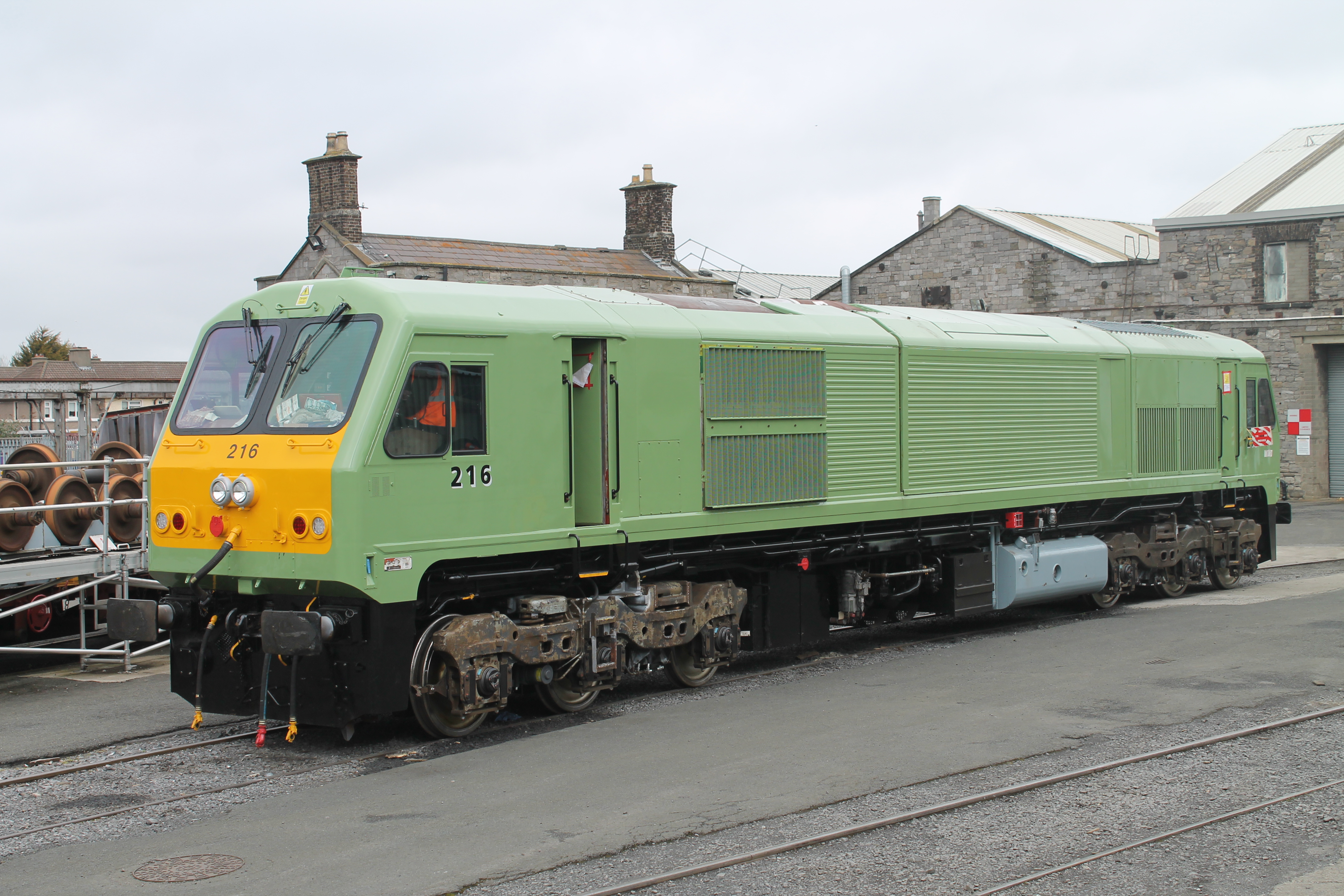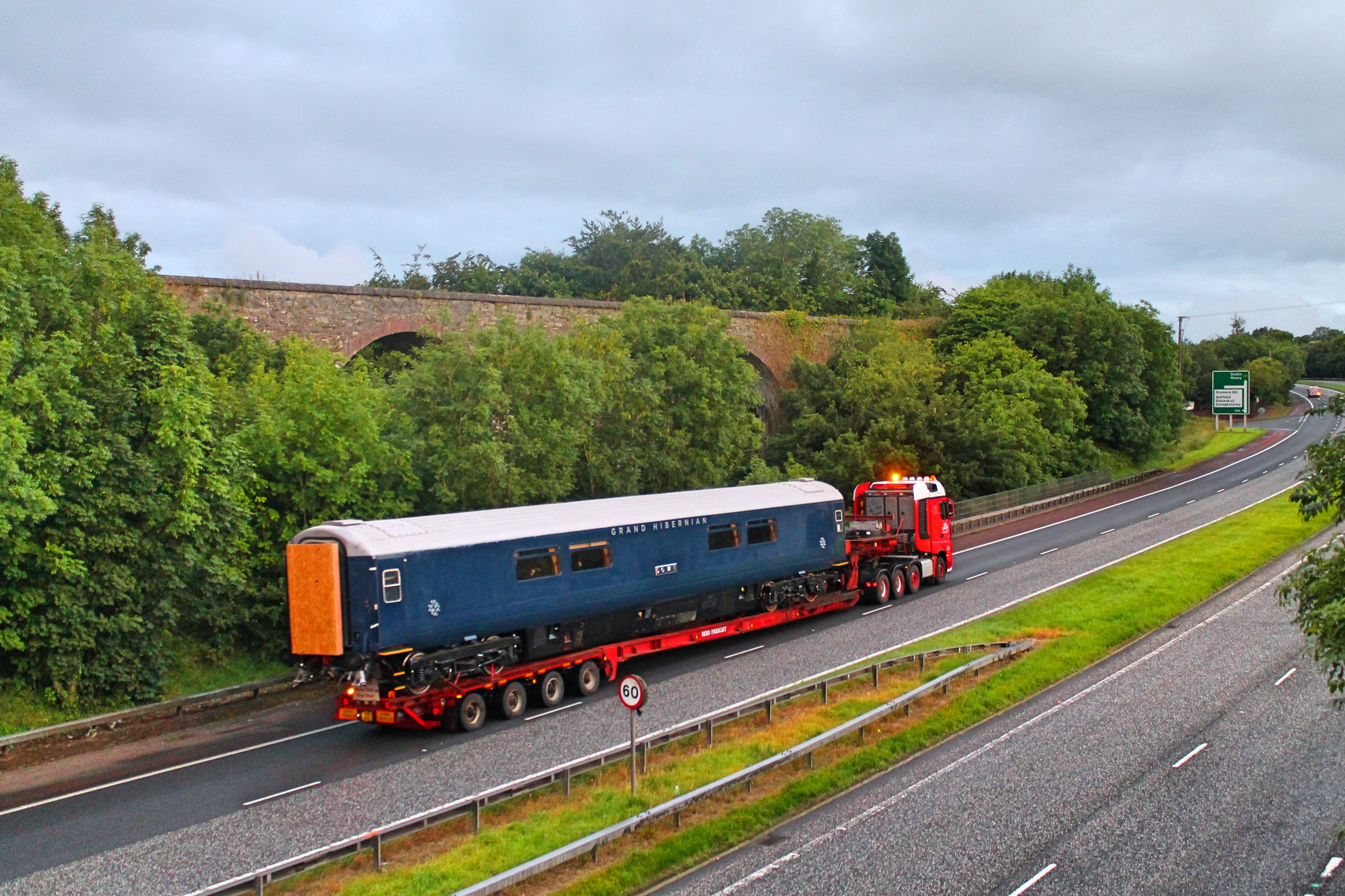Belmond Grand Hibernian on:
[Wikipedia]
[Google]
[Amazon]
The ''Belmond Grand Hibernian'' was a




'' Down'' ) leaving Antrim on 30 July 2016. All carriages were unloaded at North Wall sidings and taken by rail to Inchicore, where they were assembled into a complete train in preparation for test runs.
The Railway Gazette, 6 November 2014
* {{Wikivoyage inline Luxury trains Named passenger trains of Ireland Railway services introduced in 2016 Railway services discontinued in 2021 Rail transport in Ireland Tourism in Ireland 2016 establishments in Ireland 2021 disestablishments in Ireland
luxury train
Luxury trains are a premium travel option designed to offer a comfortable ride and evoke an association with history and heritage. Some luxury trains promote tourism in destinations across a region, while others (such as the Maharajas' Express) ...
service in Ireland
Ireland ( ; ga, Éire ; Ulster Scots dialect, Ulster-Scots: ) is an island in the Atlantic Ocean, North Atlantic Ocean, in Northwestern Europe, north-western Europe. It is separated from Great Britain to its east by the North Channel (Grea ...
. The service was operated by Belmond, the operator of several other luxury trains including the ''Venice Simplon Orient Express
The ''Venice Simplon-Orient-Express'' (VSOE) is a private luxury train service from London to Venice and other European cities. It is currently owned by Belmond Limited, Belmond, which operates 45 luxury hotels, restaurants, tourist trains and ...
''. It was officially launched on 30 August 2016 and ceased on 18 February 2021 while the train undergoes renovations.
Route
The planned routes took in some of thehistory of rail transport in Ireland
The history of rail transport in Ireland began only a decade later than that of Great Britain. By its peak in 1920, Ireland had 3,500 route miles (5,630 km). The current status is less than half that amount, with a large unserviced area arou ...
and were centred around Dublin. The service was timetabled to operate on a weekly schedule: a four-night tour of the south-west of Ireland during the week, then a two-night weekend tour to Northern Ireland
Northern Ireland ( ga, Tuaisceart Éireann ; sco, label= Ulster-Scots, Norlin Airlann) is a part of the United Kingdom, situated in the north-east of the island of Ireland, that is variously described as a country, province or region. Nort ...
. The ''Taste of Ireland'' two-night trip was to travel from Dublin to Belfast, Belfast to Waterford and back to Dublin, while the "Legends and Loughs" was to go from Dublin-Cork-Killarney-Galway-Westport and back over four nights. One night per week was planned to be available for maintenance and other activities. For the 2016 season, full six-night ''Grand Tour of Ireland'' journeys were scheduled to run Tuesday-to-Monday, as these would consist of both the south-westerly ''Legends and Loughs'' and northerly "Taste of Ireland" segments with a change-over for some passengers in Dublin on the Saturday of each week.
Rolling Stock



Carriages
The Grand Hibernian carriages were heavily renovated Mark 3s, originally built byBritish Rail Engineering Limited
British Rail Engineering Limited (BREL) was the railway systems engineering subsidiary of British Rail. Established in 1970, the maintenance arm was split as British Rail Maintenance Limited in 1987, and the design and building of trains was pr ...
at Derby Litchurch Lane Works
Derby Litchurch Lane Works (formerly Derby Carriage and Wagon Works) is a railway rolling stock factory in Derby, England. It was opened in the 19th century by the Midland Railway. The plant has produced rolling stock under the ownership of the ...
for Córas Iompair Éireann between 1980 and 1989, and withdrawn in 2009. The carriages underwent extensive engineering redesign and overhaul by Assenta Rail and were refurbished by the company in 2015 at a cost of £7 million. Internal fitting was carried out in Antrim, by Mivan. From the eleven Mark 3 carriages purchased, the train included five sleeping car
The sleeping car or sleeper (often ) is a railway passenger car (rail), passenger car that can accommodate all passengers in beds of one kind or another, for the purpose of sleeping. George Pullman was the American innovator of the sleeper car.
...
s, two restaurant car
A dining car (American English) or a restaurant car (British English), also a diner, is a railroad passenger car that serves meals in the manner of a full-service, sit-down restaurant.
It is distinct from other railroad food service cars that do ...
s for dining and an observation car
An observation car/carriage/coach (in US English, often abbreviated to simply observation or obs) is a type of railroad passenger car, generally operated in a passenger train as the rearmost carriage, with windows or a platform on the rear of th ...
. Carriage names were based on the counties of Ireland
The counties of Ireland (Irish language, Irish: ) are historic administrative divisions of the island into thirty-two units. They began as Norman structures, and as the powers exercised by the Cambro-Norman barons and the Old English (Ireland) ...
, several taken from each of the provinces of Ireland
There have been four Provinces of Ireland: Connacht (Connaught), Leinster, Munster, and Ulster. The Irish language, Irish word for this territorial division, , meaning "fifth part", suggests that there were once five, and at times Kingdom_of_ ...
. Each carriage bore a dark blue livery, 'Grand Hibernian' lettering, an enamel nameplate, and a 'Celtic knot' logo.
Locomotives
IE 201 Class
The Iarnród Éireann (IÉ) / Northern Ireland Railways 201 Class locomotives are the newest and most powerful diesel locomotives operating in Ireland and were built between 1994 and 1995 by General Motors Diesel. They are model type JT42HCW, fit ...
number 216 ''River Dodder'' has been overhauled specifically for use on the Grand Hibernian, having been repainted into the same dark blue livery as the coaches. It was built in 1994 by General Motors Diesel
General Motors Diesel was a railway diesel locomotive manufacturer located in London, Ontario, Canada. It was established in 1949 as the Canadian subsidiary of the Electro-Motive Diesel division of General Motors (EMD). In 1969 it was re-organiz ...
but placed in storage at Inchicore in 2010 following an accident. However, it was decided between Irish Rail and Belmond that 216 was the most suitable candidate to become the Grand Hibernian's dedicated locomotive, and as such it was brought back into service. In a green undercoat, it worked several test runs and freight trains in 2016 before being repainted into the Grand Hibernian's blue livery.
A second 201 class locomotive - presumedly 225 ''River Deel'' - was due to be converted for use with the Grand Hibernian in the event that 216 fails or is unavailable.
On June 24, 2017, 201 Class locomotive 209 ''River Foyle'' operated The Belmond Grand Hibernian run to Belfast.
Refurbishment
In December 2014, IÉ 201 Class locomotive number 229 moved the rake of eleven vehicles from Dublin Heuston Inchicore Works to Dublin North Wall sidings. The Mark 3 carriages in the rake were ordered as 7601, 7149, 7104, 7129, 7169, 7158, 7171, 7122, 7130, 7116 and 7137. Ten of the carriages were transported by road to Scotland in 2015 for refurbishment and painting. However, 7122 remained in Dublin and as of December 2016 is to be used for spare parts for the other vehicles in the set. It remains in Irish Rail's orange livery, with no refurbishment having taken place, in spite of it being purchased by Belmond. By mid-2016, all of the coaches had returned to Ireland to be taken to Mivan Engineering, Antrim, to have their interiors fitted. After fitting out, they were all returned to Dublin, with the last coach (No. 7149In service
Throughout the summer of 2016, several test runs took place prior to the train entering service. The first of these took place on Wednesday 10 August 2016 behind 216, which ran from Dublin to Thurles and back. The first test runs to reach Northern Ireland took place on Sunday 28 August 2016, when 201 Class No. 233 (In common user livery) stood in for 216 for a return trial from Dundalk to Belfast York Road. The final trial occurred on Monday 29 August 2016 with 216, which ran from Dublin to Portarlington and back. The Grand Hibernian was officially launched on Tuesday 30 August 2016, with Irish Rail Intercity-liveried 226 hauling the inaugural train out of Heuston station at 14:20. The final train of the season operated on Monday 24 October, and on Wednesday 26 October a return trip from Dublin to Thurles was arranged for the Irish Rail staff involved. On 15 April 2017, the Grand Hibernian was trialled south of Connolly station as far as Gorey. The 2017 season began on Tuesday 25 April. On 29 April the train ran to Gorey instead of Belfast as normally scheduled due to engineering works on the Belfast - Dublin line. On 18 February 2021 the ceasing of the operation was announced due to theCOVID-19 pandemic
The COVID-19 pandemic, also known as the coronavirus pandemic, is an ongoing global pandemic of coronavirus disease 2019 (COVID-19) caused by severe acute respiratory syndrome coronavirus 2 (SARS-CoV-2). The novel virus was first identif ...
. Belmond plans to relocate the train to a new, yet undisclosed place inside Europe.
References
External links
*The Railway Gazette, 6 November 2014
* {{Wikivoyage inline Luxury trains Named passenger trains of Ireland Railway services introduced in 2016 Railway services discontinued in 2021 Rail transport in Ireland Tourism in Ireland 2016 establishments in Ireland 2021 disestablishments in Ireland